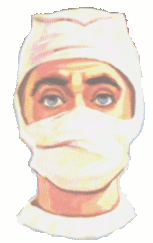
Previous Page Turn page

|
When the blood glucose level falls below 3mmol/l (55mg/dl),the following symptoms may develop: hunger,dizziness, sweating, trembling, palpitations, slurring of speech, faintness confusion and vagueness, loss of consciousness and fits.
A hypoglycaemic condition occurring at night may reveal itself only by restlessness, nightmares and a headache the morning after. (disturbed sleep)
At times one may find a surprisingly high blood glucose reading the morning after a hypoglycaemic condition: an after effect known as the Somogyi effect or dawn phenomenon. A positive ketone but negative glucose test in the first urine passed next morning is another indication of a hypo occurring during the previous night. Every diabetic has a slightly different pattern of symptoms of hypoglycaemia.
The main causes of hypoglycaemia are: Late or missed meals. These should never occur. The risks of hypoglycaemia are reduced by ensuring that you have three proper meals, together with a mid-morning, mid-afternoon and bedtime snack. (On a four-a-day injection routine,(regimen 4) the daytime snacks may not be needed but the bedtime snack is essential.)
Accidental overdose of insulin If it does occur, this can usually be dealt with by taking extra carbohydrate. However, if you realise that an accidental overdose has been given which exceeds the usual dose by more than half, contact your doctor immediately for advice.
Increased physical activity. This may not always be predictable making it essential to have lump sugar, Dextrosol tablets or something similar at hand at all times.
Alcohol. This can stop the body�s automatic correction of hypoglycaemia. When drinking alcohol (especially spirits), ensure that you eat at the same time.
Previous Page Turn page